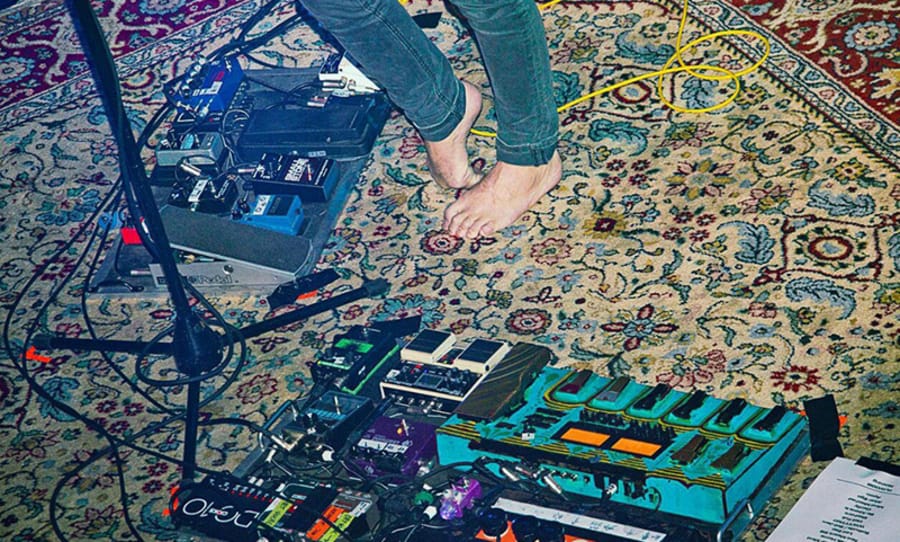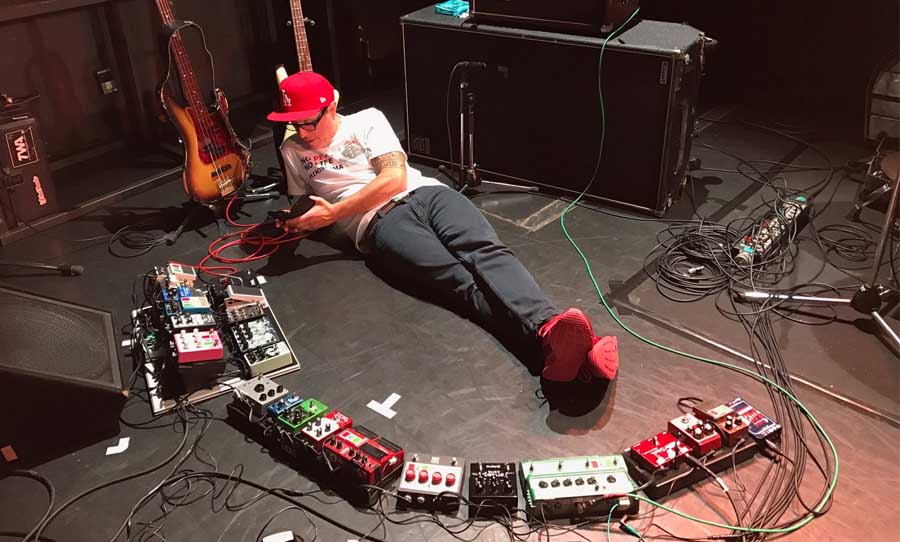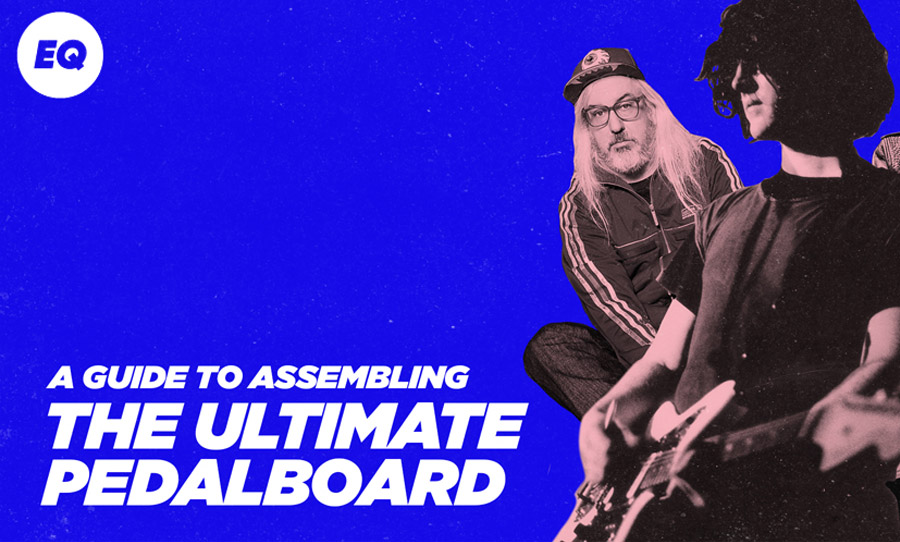Pedalboards. You can love ’em or hate ’em (if you hate them though, there might be something wrong with you). One thing’s for sure – they’re here to stay. Why? Pedals are kind of like matchbox cars for guitarists – small, collectible and oh so easy to become addicted to.
To celebrate this phenomenon, we run through the basics of the stompbox, list the best pedals that were released in 2020, and take a tour of 10 of the pedalboards that went a little too far.
For the minimalists out there, this list might not be for you. But if you’re a fan of pedalboards, gorge on these grossly excessive collections.
Pedalboards 101
by Dan Shaw
Setting up an inspiring chain of effects pedals can be one of the most satisfying experiences when tracking guitars in a recording studio. It can be the key to creating a signature tone, shaping the course of the entire mix.
The fact that pedals are tactile and somewhat limited in parameters (some more than others) adds to the personality of each pedal: their limitations define them. So, how do we get the most out of stompboxes?

If you are uninitiated to the deep and varied world of pedals, it might help to broadly categorise the sounds that they can produce, in order to narrow down your choices. Why? Well, there are thousands of pedal varieties, each with their own subtly different, or wildly individual tonal personality. If there is a tonal goal in mind, that will help guide the pedal choices.
Colour
Colour can be defined as pedals that can add a certain saturation to the signal. These typically range from compressors/clean boosters – the more subtle end of colouration, but can still possess individual characters. They are great for “hardening” the guitar tone to help them stand up in the mix.
Moving through the spectrum will take you to overdrive pedals, which can bring a little more dirt to the sound, while maintaining the ability to still mix in the clean tone. At the extreme end is full-blown fuzz and distortion for unmistakable rock tones.

Modulation
This category is particularly massive. There are many flavours of modulation, yet the basic principle is the same: the splitting of a signal, pushing one of signals out of phase, and incorporating a notch filter to sweep through the frequency spectrum.
They essentially alter the pitch of the incoming signal, creating swirling, disorienting sonic colours. Chorus pedals are a softer touch and a capable of a very smooth thickening of the sound. Phasers and flangers take things to more psychedelic territory. Vibratos ratchet up the speed of the modulation waves to emulate the vibrato circuits of classic amps of the 60’s.

Ambience
This category of effects pedal adds space to the guitar tone; the two major subcategories being delay and reverb. Delays produce noticeable echoes and typically have a few key parameters — the number of repeats (feedback), the speed of the echoes and the number of echoes.
Reverb pedals also create space but add a continuous tail on the notes rather than distinct and individual echoes. Reverbs often emulate plate and spring varieties, which offer a similar tone colour to vintage amplifiers, but some can also produce near-endless ambience, like digital reverb engines that were popular in the ’80s.
There are no hard rules regarding the employment of stompboxes in your effects chain, but it may be worth categorising your stompboxes in order to understand their strengths and weaknesses and get the most out of each one. The ‘set and forget’ mentality won’t cut it in approaching other the sounds in the studio. Deconstruction, reconstruction and experimentation with effects chains can set you on the path to creating a signature guitar tone of your own.

The 8 best pedals of 2020
by Jeremy Span
Fredric Effects Blue Monarch
Fredric Effects’ Blue Monarch recreates the coveted ‘Bluesbreaker’ tone made popular back in 1966 when Eric Clapton cranked his JTM 45 Marshall amp into the ‘break up’ zone during his short-lived stint John Mayall & the Bluesbreakers. The Blue Monarch is also influenced by Analog Man’s King of Tones pedal.
The popular KOT overdrive pedal managed to capture the immortal tone in a stomp-box sized unit when it was introduced in the ’90s. Fredric Effects’ take on the pedal, however, is a much more affordable package.
The Blue Monarch also updates KOT’s design with clipping and treble boosting options controlled from the exterior of the pedal (as opposed Analog Man installing theirs on the inside of the pedal!). There’s an additional boost option that adds even more functionality: an increase to the maximum gain makes this a multifaceted pedal for guitarists wanting to go beyond the break-up zone and into a fully-fledged crunch.
Read more about this nifty blues unit at Fredric Effects.
Warm Audio Jet Phaser
Warm audio made their guitar pedal debut with this ’70s inspired sonic modulator. Warm Audio’s Jet Phaser is an authentic recreation of the famous Roland Jet Phaser pedal which was adopted by Larry Graham as the core of his bass sound with Sly and The Family Stone. Warm Audio has emulated its sonic capabilities and striking looks.
The Jet Phaser comes with six modes: two Phase modes and four Jet modes. The two Phase options differ between being a subtle and more exaggerated effect, but things get a little more out of control with the Jet modes, which provide varying fuzz onslaughts paired with phasing. From psychedelia to funk — and everything in between — this pedal is a lot of fun.
See more at Warm Audio.
Walrus Audio Juliana Deluxe
Chorus and Vibrato are like cookies and cream. The Julianna Deluxe pedal from Walrus Audio delivers this killer combo in spades. Their OG Julia Chorus/Vibrato already conjured up lush, tonal soundscapes. But this year saw the emergence of Julia’s “long lost sister” Julianna “from the murky ocean depths” – with deluxe features that offer mild, smooth chorus to extremely washy vibrato.
A tap tempo option with the Div switch is just the start of the deluxe features that the Julianna offers. There’s a Shape switch that offers sine, triangle, or random LFO waves to modulate pitch. It also possesses a stereo input and output that lets you explore the different blending options of your wet and dry signals in each channel. The best feature on this pedal? The Drift mode — it gently speeds up and slows down the current rate of the LFO. It literally modulates your modulation!
Head over to the Walrus Audio for more info.
Crazy Tube Circuits Constellation Fuzz
The stars aligned for the creation of the Constellation — CV7003, an all-analog, hand-built fuzz pedal that recreates the sonic qualities of 5 iconic fuzz circuits. Voicings include a Vox Tone Bender inspired fuzz circuit, a recreation of the soaring gain 3-transistor fuzz circuit and a treble booster as close as it gets to the real thing. There’s even an additional original tone that they hope to be a “future classic combination”.
Crazy Tube Circuits have gone back to where it all began, with the key to the Constellation being the carefully hand-selected NOS germanium CV7003 transistors. These were originally made in the UK by Texas Instruments way back in 1968 — an important year for the development of the fuzz sound. The Constellation is only limited to 200 units worldwide.
Read the complete specs at Crazy Tube Circuits’ website.
Strymon NightSky Reverb
Strymon’s NightSky is in an insane time-warped reverberator pedal that unlocks otherworldly, sonic exploration with a range of ambient tone-shaping possibilities. This won’t just make your pedalboard — it will complete it, taking you to the depths of outer space and beyond. With this pedal at your disposal, you’ll be able to create vast soundscapes with just a few notes from your instrument. The NightSky provides endless experimentation.
There are three reverb architectures at your disposal — from sparse to plate-like, to slow atmospheric swells. Modulation types include classic chorus and vibrato pitch bending to intense, synthy filters with various waveforms that include a touch-sensitive envelope that closes in on the reverb tails. Pitch shifting options include Strymon’s octave shimmer as well other exciting interval modes.
The reverb tone can be manipulated at various points in the signal chain too, from the glimmer at the input which creates ethereal upper and lower harmonics to powerful low and high-cut filters at the end of the signal chain. There’s even pre and post distortion to give you maximum control over reverb gain.
Check out Strymon for more info on this comprehensive reverb unit.
Red Witch Synthatron II
You can literally turn your guitar into a full-on synthesizer with the Synthatron II from Red Witch. “Analog synth mayhem” lies in the circuitry of this monster of a stomp-box. The Synthatron II features dual analog synthesizers, with controls of up to two octaves up and one octave down and independent synth and filter capabilities with sample hold and an envelope filters.
The Synthatron II essentially takes you on a greatest hits of ’70s synth favourites, ranging from retro, 8-bit tones, all the way through to squelchy acid house sounds reminiscent of the TB-303 and funky envelope filter textures. It’s the best way for a guitarist to wet their palette in the world of synth without having to learn a new instrument.
Read the full write up of features at Red Witch.
Redbeard Honey Badger
Way back at the strait of the year, Redbeard Effects introduced us to the Honey Badger Octave Fuzz – an aggressive and reckless fuzz pedal that pushes guitar tone to the edge… and then further.
The Honey Badger offers an octave drop with the Divide knob, that can be blended between the -2 and -1 Octaves, resulting in a heavy and distinctive fuzz sound. There’s also a footswitch for the sub-octaves, and 2-band bass and treble EQ knobs. This a unique addition to any pedalboard and hell of a lot of fun doom-laden riffs.
Head to Redbeard Effects for more information.
EHX Oceans 12
The Electro-Harmonix Oceans 12 provides two simultaneous and independently controlled stereo reverb engines with twelve presets of ocean reverb goodness. EHX has packed this sonic shaper with lots of features including series and parallel control for the dual reverbs, advanced I/O allowing for stereo in/out or mono send/return with pre and post reverb options.
The ocean-like textures are provided with the Tide Control for stereo image alteration, a Lo-fi Control, an infinite attenuation control and an input jack for external expression and 3-button footswitch control.
You can control the reverb with a Tail switch that provides the choice of whether the reverb effect fades out naturally or stops immediately when the pedal is switched to bypass. Alternatively, you can produce infinite reverb which can be played over with a different reverb effect.
The Oceans 12’s reverbs include ROOM reverb algorithms, modelled after a lively room and a spacious performance hall, SPRING vintage 1962 Fender tube reverb emulation, recreations of the smooth, metal PLATE reverb often used in high-end recording studios during the ’60s and ‘70s and REVERSE reverb effects with echo.
Read more at EHX.
10 pedalboards that took things too far
by Dan Shaw
Sweetwater and Rob Scallon
Though it’s not the rig of a touring artist, the feat pulled off by Scallon and the mega music retailer Sweetwater can’t be ignored. A total of 319 pedals were connected and switched on – eventually – and run through 7 Marshall heads and 14 cabinets.
The resulting sound, well, let’s just say it got a bit loud. It’s not really the most tour-friendly setup, considering that you need an army of helpers to make any sounds. It happened though, and we can only wait with bated breath until this insane record is broken again.
Kevin Shields – My Bloody Valentine
My Bloody Valentine burst onto the scene in the early ’90s with their tidal waves of guitar creating the genre of shoegaze. To craft these unique sounds, Kevin Shields relied on novel uses of the tremolo arm, a selection of alternate tunings and as you can imagine, an unhealthy amount of effects pedals.
Touring this rig comes with obvious complications, but this photo indicates that he keeps on top of it all by separating the epic setup into an array of bite-sized boards. Still though, Shields must’ve developed some pretty handy tapdancing skills over the years.

The Edge – U2
Has there ever been a touring juggernaut on the scale of U2? Stadium rock is the norm for this giant band from Ireland and thus, guitarist The Edge has more than a few choice toys to play with. Looking at the relatively neat and compact assortment below you might think, what gives?
Well, if you look closely, you’ll notice the labels under the buttons of that central panel. They actually work as switches for the racks of outboard that make up the iconic U2 guitar sound. So, The Edge doesn’t have so much of an excessive pedalboard, but an entire studio that follows him around the world.

Adam Granduciel – The War On Drugs
If you’ve ever listened to The War On Drugs – the project of singer/songwriter/producer/guitar lord Adam Granduciel, you’ll notice that the guy pays very close attention to the sonic textures on his records. If sweeping rock epics with undulating, atmospheric guitars is your jam, then you’ll be a fan.
On stage, Granduciel likes to wrap himself in a sonic cocoon – behind him an array of guitar amps and in front, a smorgasbord of stompboxes and switches for outboard gear. Beautiful stuff.

Adrian Belew
Adrian Belew has made his name in pushing the boundaries of rock guitar with ceaseless experimentation in his solo work, as frontman for King Crimson and collaborations with Frank Zappa, David Bowie, Laurie Anderson, Nine Inch Nails and more. As you might expect, he’s not afraid of using expansive pedalboards.
This rig from the Adrian Belew Power Trio days comprises not only pedals but a whole studio’s worth of synths, mixers, drum machines and more. For someone who’s constantly on the search for new tones, surely this collection is only going to get bigger and better.

Doug Wimbish – Living Colour
But what about the bass players I hear you ask? There’s probably not as many bassists with over-the-top pedalboards, but Doug Wimbish from rock-funk fusion legends Living Colour certainly bucks the trend.
His rig encompasses everything you could ever need from a bass tone, plus a few extra elements. There’s a few bass archetypes – the SansAmp springs to mind – but he clearly gets experimental, with a selection of modulation pedals. There’s even some digital sampling thrown into the mix.

John Frusciante – Red Hot Chili Peppers
Like U2, Red Hot Chili Peppers are a touring behemoth who specialise in stadium rock. And since Frusciante began his long stint with the band as a teenager, the Chili Peppers’ fame – and the size of his pedalboard – grew exponentially.
As pedalboards grow, guitarists tend to arrange them in a semi-circular fashion to make them easier to reach. Frusciante’s is in a rare straight line formation and it makes you wonder how on earth he can reach both ends in quick succession. Well, if it ain’t broke…

J Mascis – Dinosaur Jr.
If you’ve experienced the multi-layered distortion onslaught of Dinosaur Jr. you might have guessed that there was a bit of grunt under the hood when it comes to pedals. One look at the gratuitously gorgeous pedalboard of J Mascis and you’ll see how this magical sound came to be.
It’s about as grimy and gritty as you’d expect, with years of scars from the road and absolutely crammed with all kinds of distortion and fuzz (including the rare Ram’s Head Big Muff). Also, it must surely win the prize for the beefiest power supply on the list.

Andy Summers – The Police
Andy Summers, most famous for creating some of recent history’s more memorable pieces of guitar riffage with The Police, has taken the semicircle concept to the extreme. When he was in the studio recently recording a new solo album, he went full circle.
One of the most famous guitar tone innovators of the ’80s, he famously eschewed extreme distortion, favouring heavily modulated tones and was an early adopter of guitar synthesis.

Juan Alderete
L.A. bass player Juan Alderete has played with Racer X, The Mars Volta and grew up on a diet of jazz and prog. His vast pedalboard reflects the myriad influences that make up his musical personality.
Reportedly at over 400 pedals deep into his collection, Alderete’s board below obviously doesn’t utilise all of his pedals, but it’s still more than enough to get through a gig. His obsession has spilled over into Pedals and Effects – a website that’s dedicated to all things new in the pedal world. Suffice it to say, if you’re in the market for a new pedal, Alderete’s probably got something to say about it.



